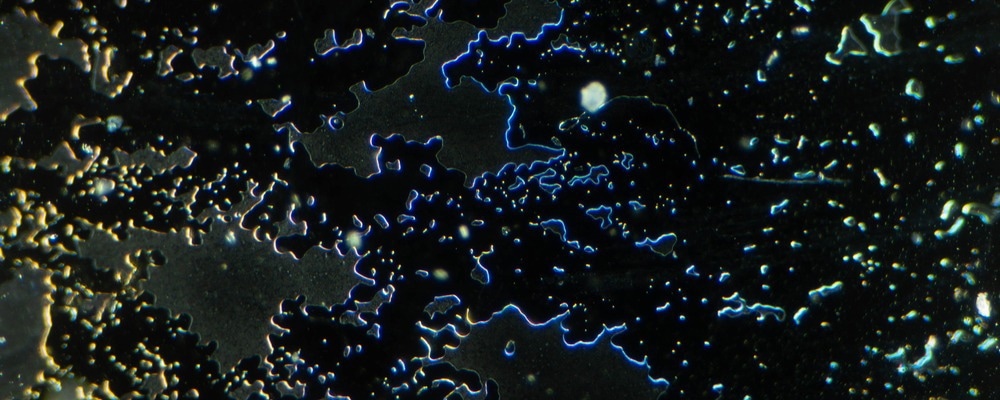A paper recently published in the journal Nature Physics demonstrated the transition of a photonic metamaterial/classical metamaterial nanostructure to a state that shows the same defining characteristics of a continuous time crystal.

Image Credit: luchschenF/Shutterstock.com
Importance of Continuous Time Crystals
Time crystals, a new phase of matter with broken time-translation symmetry, have received significant attention in recent years. In condensed matter physics, a time crystal is a quantum many-body system whose lowest energy state is one in which the particles remain in continuous oscillatory motion.
Discrete time crystals display discretely broken time-translation symmetry under the influence of external modulated parametric drive. This type of time crystal has been realized on different platforms, including a disordered spin impurity ensemble in diamond, an interacting spin chain of trapped atomic ions, a crystal nuclear spin lattice in an ammonium dihydrogen phosphate crystal, and a Bose-Einstein condensate of magnons.
Crucial signatures of the many-body-localized discrete time crystal state have also been observed on superconducting qubit arrays in a quantum processor and on an individually controllable carbon-13 nuclear spin-based quantum simulation platform.
Recently, a quantum time crystal that continuously breaks time-translation symmetry has been observed in an atomic Bose-Einstein condensate within an optical cavity. The quantum continuous time crystal manifested in the emergence of spontaneous intracavity photon number oscillations under optical pumping. The pump laser was continuously operated to maintain the continuous time-translation symmetry while inducing a transition to the symmetry-broken state.
Continuous time crystals are more suitable for investigating topological and entanglement phases in arrays of quantum simulations and levitated particles compared to discrete time crystals due to spontaneous transition to a robust oscillatory state in reaction to a time-independent external stimulus.
Continuous Time Crystal Based on a Photonic Metamaterial
In this study, researchers demonstrated a spontaneous transition of a photonic metamaterial/two-dimensional (2D) periodic plasmonic metamolecule lattice supported on doubly clamped flexible nanowire beams cut from a semiconductor membrane to a state of continuous optical transmissivity oscillations at room temperature when illuminated using a coherent light that stimulates the interaction among metamolecules.
The experimental sample was synthesized using focused ion beam milling from a gold-coated silicon nitride nano-membrane. Additionally, the plasmonic metamolecules/Π-shaped arrangements of three gold nanorods were supported in a way that the mutual displacement of nanowires can strongly affect the resonant plasmonic scattering properties of metamolecules.
This coupling between the optical and mechanical properties of the lattice allowed optical detection of the state of the lattice by monitoring its transmissivity. Recent studies have demonstrated that picometric thermomechanical fluctuations in similar structures can modulate the transmitted and scattered light measurably.
Key Research Findings
The artificial photonic material was successfully driven to a state that showed all major characteristics of a continuous time crystal, including the continuously broken time-translation symmetry.
The spectrally dispersed individual nanowire thermal fluctuations became synchronous spatially coherent oscillations over the illuminated ensemble when the incident optical power was above a threshold level.
Time-independent excitation in the form of coherent light illumination, which was resonant with the metamolecule plasmonic modes, spontaneously triggered robust periodic optical transmissivity oscillation.
The oscillations were generated due to electromagnetic dipole-dipole interactions and many-body interactions among metamolecules induced by the incident light, and the individual nanowire thermal oscillations were replaced by the superradiant, coherent motion of the illuminated ensemble.
A first-order phase transition to the coherent oscillatory regime was observed. Additionally, the transmissivity oscillations were robust to extremely small perturbations, and a random oscillation phase was detected for different realizations.
Moreover, the indefinite persistence of the synchronous oscillation and synchronization of the illuminated ensemble indicated the long-range order in time and long-range order in space, respectively.
Conclusion and Future Outlook
The control and simplicity achieved by researchers with the nano-opto-mechanical platform offered a new dynamical many-body system class that broadens the concepts of spontaneous symmetry breaking and long-range order into the time domain.
Thus, this study paves the way for further research on dynamic many-body states in the strongly correlated regime within a classical system that can complement spin and cold atom platforms where many-body quantum states of fermionic/bosonic matter can be investigated.
These studies can be facilitated through direct access to nanowire positions using atomic-scale techniques to detect localization and nanoscale cantilever and string movement. The platform can also enable the development of new photonic and optical devices.
Light-induced step-like transitions to a robust super-radiant mode can be utilized in new optically controlled modulators and frequency mixers among photonic technologies. Such triggering can also be used in new all-optical timing applications where oscillation periods are counted after triggering. Additionally, the random phase of spontaneous oscillations can be exploited in classical platform-based all-optical pseudo-random number generators.
More from AZoOptics: Gas-Assisted Etching in Photonics Fabrication
References and Further Reading
Fadelli, I. (2023). The realization of a continuous time crystal based on a photonic metamaterial [Online] Available at https://phys.org/news/2023-05-crystal-based-photonic-metamaterial.html (Accessed on 16 May 2023)
Liu, T., Ou, J. -Y., MacDonald, K. F., Zheludev, N. (2023). Photonic metamaterial analog of a continuous time crystal. Nature Physics. https://doi.org/10.1038/s41567-023-02023-5
Wilczek, F. (2012). Quantum Time Crystals. Physical Review Letters, 109. https://journals.aps.org/prl/abstract/10.1103/PhysRevLett.109.160401
Disclaimer: The views expressed here are those of the author expressed in their private capacity and do not necessarily represent the views of AZoM.com Limited T/A AZoNetwork the owner and operator of this website. This disclaimer forms part of the Terms and conditions of use of this website.